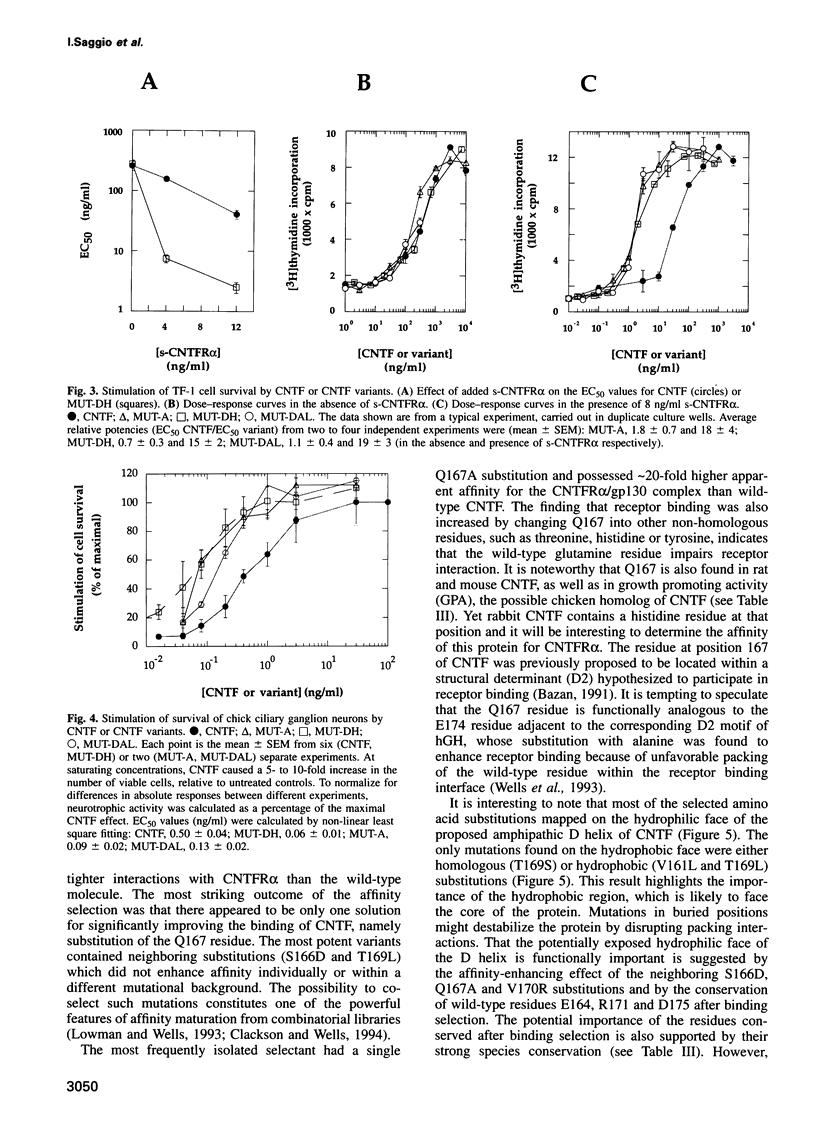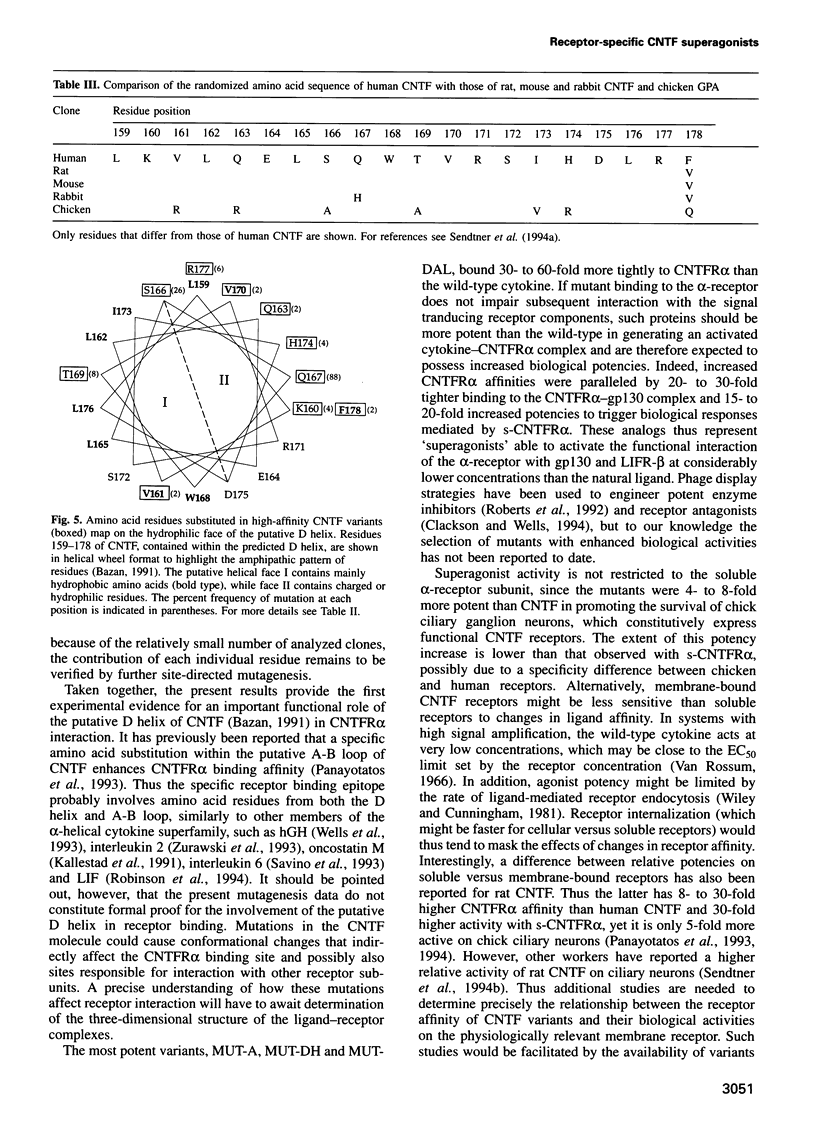Abstract
Human CNTF is a neurocytokine that elicits potent neurotrophic effects by activating a receptor complex composed of the ligand-specific alpha-receptor subunit (CNTFR alpha) and two signal transducing proteins, which together constitute a receptor for leukemia inhibitory factor (LIFR). At high concentrations, CNTF can also activate the LIFR and possibly other cross-reactive cytokine receptors in the absence of CNTFR alpha. To gain a better understanding of its structure-function relationships and to develop analogs with increased receptor specificity, the cytokine was submitted to affinity maturation using phage display technology. Variants with greatly increased CNTFR alpha affinity were selected from a phage-displayed library of CNTF variants carrying random amino acid substitutions in the putative D helix. Selected variants contained substitutions of the wild-type Gln167 residue, either alone or in combination with neighboring mutations. These results provide evidence for an important functional role of the mutagenized region in CNTFR alpha binding. Affinity enhancing mutations conferred to CNTF increased potency to trigger biological effects mediated by CNTFR alpha and enhanced neurotrophic activity on chicken ciliary neurons. In contrast, the same mutations did not potentiate the CNTFR alpha-independent receptor actions of CNTF. These CNTF analogs thus represent receptor-specific superagonists, which should help to elucidate the mechanisms underlying the pleiotropic actions of the neurocytokine.
Full text
PDF









Selected References
These references are in PubMed. This may not be the complete list of references from this article.
- Baumann H., Ziegler S. F., Mosley B., Morella K. K., Pajovic S., Gearing D. P. Reconstitution of the response to leukemia inhibitory factor, oncostatin M, and ciliary neurotrophic factor in hepatoma cells. J Biol Chem. 1993 Apr 25;268(12):8414–8417. [PubMed] [Google Scholar]
- Bazan J. F. Neuropoietic cytokines in the hematopoietic fold. Neuron. 1991 Aug;7(2):197–208. doi: 10.1016/0896-6273(91)90258-2. [DOI] [PubMed] [Google Scholar]
- Clackson T., Wells J. A. In vitro selection from protein and peptide libraries. Trends Biotechnol. 1994 May;12(5):173–184. doi: 10.1016/0167-7799(94)90079-5. [DOI] [PubMed] [Google Scholar]
- Cormack B. P., Struhl K. Regional codon randomization: defining a TATA-binding protein surface required for RNA polymerase III transcription. Science. 1993 Oct 8;262(5131):244–248. doi: 10.1126/science.8211143. [DOI] [PubMed] [Google Scholar]
- Davis S., Aldrich T. H., Ip N. Y., Stahl N., Scherer S., Farruggella T., DiStefano P. S., Curtis R., Panayotatos N., Gascan H. Released form of CNTF receptor alpha component as a soluble mediator of CNTF responses. Science. 1993 Mar 19;259(5102):1736–1739. doi: 10.1126/science.7681218. [DOI] [PubMed] [Google Scholar]
- Derbyshire K. M., Salvo J. J., Grindley N. D. A simple and efficient procedure for saturation mutagenesis using mixed oligodeoxynucleotides. Gene. 1986;46(2-3):145–152. doi: 10.1016/0378-1119(86)90398-7. [DOI] [PubMed] [Google Scholar]
- Dittrich F., Thoenen H., Sendtner M. Ciliary neurotrophic factor: pharmacokinetics and acute-phase response in rat. Ann Neurol. 1994 Feb;35(2):151–163. doi: 10.1002/ana.410350206. [DOI] [PubMed] [Google Scholar]
- Gearing D. P. The leukemia inhibitory factor and its receptor. Adv Immunol. 1993;53:31–58. doi: 10.1016/s0065-2776(08)60497-6. [DOI] [PubMed] [Google Scholar]
- Gearing D. P., Ziegler S. F., Comeau M. R., Friend D., Thoma B., Cosman D., Park L., Mosley B. Proliferative responses and binding properties of hematopoietic cells transfected with low-affinity receptors for leukemia inhibitory factor, oncostatin M, and ciliary neurotrophic factor. Proc Natl Acad Sci U S A. 1994 Feb 1;91(3):1119–1123. doi: 10.1073/pnas.91.3.1119. [DOI] [PMC free article] [PubMed] [Google Scholar]
- Glaser S. M., Yelton D. E., Huse W. D. Antibody engineering by codon-based mutagenesis in a filamentous phage vector system. J Immunol. 1992 Dec 15;149(12):3903–3913. [PubMed] [Google Scholar]
- Henderson J. T., Seniuk N. A., Richardson P. M., Gauldie J., Roder J. C. Systemic administration of ciliary neurotrophic factor induces cachexia in rodents. J Clin Invest. 1994 Jun;93(6):2632–2638. doi: 10.1172/JCI117276. [DOI] [PMC free article] [PubMed] [Google Scholar]
- Ip N. Y., McClain J., Barrezueta N. X., Aldrich T. H., Pan L., Li Y., Wiegand S. J., Friedman B., Davis S., Yancopoulos G. D. The alpha component of the CNTF receptor is required for signaling and defines potential CNTF targets in the adult and during development. Neuron. 1993 Jan;10(1):89–102. doi: 10.1016/0896-6273(93)90245-m. [DOI] [PubMed] [Google Scholar]
- Kallestad J. C., Shoyab M., Linsley P. S. Disulfide bond assignment and identification of regions required for functional activity of oncostatin M. J Biol Chem. 1991 May 15;266(14):8940–8945. [PubMed] [Google Scholar]
- Kishimoto T., Taga T., Akira S. Cytokine signal transduction. Cell. 1994 Jan 28;76(2):253–262. doi: 10.1016/0092-8674(94)90333-6. [DOI] [PubMed] [Google Scholar]
- Kitamura T., Tange T., Terasawa T., Chiba S., Kuwaki T., Miyagawa K., Piao Y. F., Miyazono K., Urabe A., Takaku F. Establishment and characterization of a unique human cell line that proliferates dependently on GM-CSF, IL-3, or erythropoietin. J Cell Physiol. 1989 Aug;140(2):323–334. doi: 10.1002/jcp.1041400219. [DOI] [PubMed] [Google Scholar]
- Lindsay R. M., Wiegand S. J., Altar C. A., DiStefano P. S. Neurotrophic factors: from molecule to man. Trends Neurosci. 1994 May;17(5):182–190. doi: 10.1016/0166-2236(94)90099-x. [DOI] [PubMed] [Google Scholar]
- Lowman H. B., Wells J. A. Affinity maturation of human growth hormone by monovalent phage display. J Mol Biol. 1993 Dec 5;234(3):564–578. doi: 10.1006/jmbi.1993.1612. [DOI] [PubMed] [Google Scholar]
- Nesbitt J. E., Fuentes N. L., Fuller G. M. Ciliary neurotrophic factor regulates fibrinogen gene expression in hepatocytes by binding to the interleukin-6 receptor. Biochem Biophys Res Commun. 1993 Jan 29;190(2):544–550. doi: 10.1006/bbrc.1993.1082. [DOI] [PubMed] [Google Scholar]
- Oppenheim R. W., Prevette D., Yin Q. W., Collins F., MacDonald J. Control of embryonic motoneuron survival in vivo by ciliary neurotrophic factor. Science. 1991 Mar 29;251(5001):1616–1618. doi: 10.1126/science.2011743. [DOI] [PubMed] [Google Scholar]
- Panayotatos N., Everdeen D., Liten A., Somogyi R., Acheson A. Recombinant human CNTF receptor alpha: production, binding stoichiometry, and characterization of its activity as a diffusible factor. Biochemistry. 1994 May 17;33(19):5813–5818. doi: 10.1021/bi00185a020. [DOI] [PubMed] [Google Scholar]
- Panayotatos N., Radziejewska E., Acheson A., Pearsall D., Thadani A., Wong V. Exchange of a single amino acid interconverts the specific activity and gel mobility of human and rat ciliary neurotrophic factors. J Biol Chem. 1993 Sep 5;268(25):19000–19003. [PubMed] [Google Scholar]
- Paonessa G., Graziani R., De Serio A., Savino R., Ciapponi L., Lahm A., Salvati A. L., Toniatti C., Ciliberto G. Two distinct and independent sites on IL-6 trigger gp 130 dimer formation and signalling. EMBO J. 1995 May 1;14(9):1942–1951. doi: 10.1002/j.1460-2075.1995.tb07186.x. [DOI] [PMC free article] [PubMed] [Google Scholar]
- Raff M. C., Barres B. A., Burne J. F., Coles H. S., Ishizaki Y., Jacobson M. D. Programmed cell death and the control of cell survival: lessons from the nervous system. Science. 1993 Oct 29;262(5134):695–700. doi: 10.1126/science.8235590. [DOI] [PubMed] [Google Scholar]
- Rende M., Muir D., Ruoslahti E., Hagg T., Varon S., Manthorpe M. Immunolocalization of ciliary neuronotrophic factor in adult rat sciatic nerve. Glia. 1992;5(1):25–32. doi: 10.1002/glia.440050105. [DOI] [PubMed] [Google Scholar]
- Roberts B. L., Markland W., Ley A. C., Kent R. B., White D. W., Guterman S. K., Ladner R. C. Directed evolution of a protein: selection of potent neutrophil elastase inhibitors displayed on M13 fusion phage. Proc Natl Acad Sci U S A. 1992 Mar 15;89(6):2429–2433. doi: 10.1073/pnas.89.6.2429. [DOI] [PMC free article] [PubMed] [Google Scholar]
- Robinson R. C., Grey L. M., Staunton D., Vankelecom H., Vernallis A. B., Moreau J. F., Stuart D. I., Heath J. K., Jones E. Y. The crystal structure and biological function of leukemia inhibitory factor: implications for receptor binding. Cell. 1994 Jul 1;77(7):1101–1116. doi: 10.1016/0092-8674(94)90449-9. [DOI] [PubMed] [Google Scholar]
- Rodbard D., Frazier G. R. Statistical analysis of radioligand assay data. Methods Enzymol. 1975;37:3–22. doi: 10.1016/s0076-6879(75)37003-1. [DOI] [PubMed] [Google Scholar]
- Saggio I., Gloaguen I., Laufer R. Functional phage display of ciliary neurotrophic factor. Gene. 1995 Jan 11;152(1):35–39. doi: 10.1016/0378-1119(94)00733-9. [DOI] [PubMed] [Google Scholar]
- Saggio I., Paonessa G., Gloaguen I., Graziani R., De Serio A., Laufer R. Nonradioactive receptor binding assay for ciliary neurotrophic factor. Anal Biochem. 1994 Sep;221(2):387–391. doi: 10.1006/abio.1994.1430. [DOI] [PubMed] [Google Scholar]
- Savino R., Lahm A., Giorgio M., Cabibbo A., Tramontano A., Ciliberto G. Saturation mutagenesis of the human interleukin 6 receptor-binding site: implications for its three-dimensional structure. Proc Natl Acad Sci U S A. 1993 May 1;90(9):4067–4071. doi: 10.1073/pnas.90.9.4067. [DOI] [PMC free article] [PubMed] [Google Scholar]
- Schooltink H., Stoyan T., Roeb E., Heinrich P. C., Rose-John S. Ciliary neurotrophic factor induces acute-phase protein expression in hepatocytes. FEBS Lett. 1992 Dec 21;314(3):280–284. doi: 10.1016/0014-5793(92)81489-9. [DOI] [PubMed] [Google Scholar]
- Sendtner M., Carroll P., Holtmann B., Hughes R. A., Thoenen H. Ciliary neurotrophic factor. J Neurobiol. 1994 Nov;25(11):1436–1453. doi: 10.1002/neu.480251110. [DOI] [PubMed] [Google Scholar]
- Sendtner M., Dittrich F., Hughes R. A., Thoenen H. Actions of CNTF and neurotrophins on degenerating motoneurons: preclinical studies and clinical implications. J Neurol Sci. 1994 Jul;124 (Suppl):77–83. doi: 10.1016/0022-510x(94)90187-2. [DOI] [PubMed] [Google Scholar]
- Sendtner M., Kreutzberg G. W., Thoenen H. Ciliary neurotrophic factor prevents the degeneration of motor neurons after axotomy. Nature. 1990 May 31;345(6274):440–441. doi: 10.1038/345440a0. [DOI] [PubMed] [Google Scholar]
- Sendtner M., Schmalbruch H., Stöckli K. A., Carroll P., Kreutzberg G. W., Thoenen H. Ciliary neurotrophic factor prevents degeneration of motor neurons in mouse mutant progressive motor neuronopathy. Nature. 1992 Aug 6;358(6386):502–504. doi: 10.1038/358502a0. [DOI] [PubMed] [Google Scholar]
- Smith G. P., Scott J. K. Libraries of peptides and proteins displayed on filamentous phage. Methods Enzymol. 1993;217:228–257. doi: 10.1016/0076-6879(93)17065-d. [DOI] [PubMed] [Google Scholar]
- Stahl N., Davis S., Wong V., Taga T., Kishimoto T., Ip N. Y., Yancopoulos G. D. Cross-linking identifies leukemia inhibitory factor-binding protein as a ciliary neurotrophic factor receptor component. J Biol Chem. 1993 Apr 15;268(11):7628–7631. [PubMed] [Google Scholar]
- Stahl N., Yancopoulos G. D. The tripartite CNTF receptor complex: activation and signaling involves components shared with other cytokines. J Neurobiol. 1994 Nov;25(11):1454–1466. doi: 10.1002/neu.480251111. [DOI] [PubMed] [Google Scholar]
- Taga T., Narazaki M., Yasukawa K., Saito T., Miki D., Hamaguchi M., Davis S., Shoyab M., Yancopoulos G. D., Kishimoto T. Functional inhibition of hematopoietic and neurotrophic cytokines by blocking the interleukin 6 signal transducer gp130. Proc Natl Acad Sci U S A. 1992 Nov 15;89(22):10998–11001. doi: 10.1073/pnas.89.22.10998. [DOI] [PMC free article] [PubMed] [Google Scholar]
- Wells J. A., Cunningham B. C., Fuh G., Lowman H. B., Bass S. H., Mulkerrin M. G., Ultsch M., deVos A. M. The molecular basis for growth hormone-receptor interactions. Recent Prog Horm Res. 1993;48:253–275. [PubMed] [Google Scholar]
- Wiley H. S., Cunningham D. D. A steady state model for analyzing the cellular binding, internalization and degradation of polypeptide ligands. Cell. 1981 Aug;25(2):433–440. doi: 10.1016/0092-8674(81)90061-1. [DOI] [PubMed] [Google Scholar]
- Zhang X. G., Gu J. J., Lu Z. Y., Yasukawa K., Yancopoulos G. D., Turner K., Shoyab M., Taga T., Kishimoto T., Bataille R. Ciliary neurotropic factor, interleukin 11, leukemia inhibitory factor, and oncostatin M are growth factors for human myeloma cell lines using the interleukin 6 signal transducer gp130. J Exp Med. 1994 Apr 1;179(4):1337–1342. doi: 10.1084/jem.179.4.1337. [DOI] [PMC free article] [PubMed] [Google Scholar]
- Zurawski S. M., Vega F., Jr, Doyle E. L., Huyghe B., Flaherty K., McKay D. B., Zurawski G. Definition and spatial location of mouse interleukin-2 residues that interact with its heterotrimeric receptor. EMBO J. 1993 Dec 15;12(13):5113–5119. doi: 10.1002/j.1460-2075.1993.tb06206.x. [DOI] [PMC free article] [PubMed] [Google Scholar]


